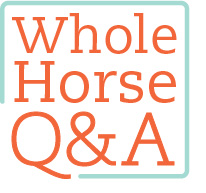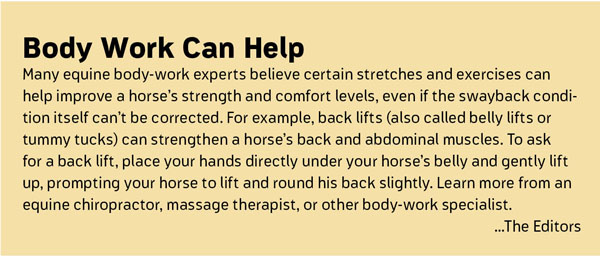Q I know someone who rides her elderly gelding despite his swayed back. What causes swayback, and can anything be done to prevent it? Can a swaybacked horse be ridden?
[READ: Senior Horse Activities]

LINDSEY WOOD, Virginia
A A swayed back can be caused by weakened soft-tissue support of the spinal column combined with the weight of the abdomen pulling downward; a vertebral conformational defect; or, much less commonly, trauma resulting in injury to the vertebral column.
In general, there are two broad classifications of swaybacked horses. Most commonly, we think of the older horse that starts sagging as the soft-tissue structures supporting his back loosen and the weight of his belly starts to pull on his spinal column. Usually, these forces result in gentle angles in the spine that don’t reduce a horse’s quality of life. These horses don’t appear to be in pain and live out their years oblivious to the condition. Older broodmares seem to be at higher risk as a result of having carried large loads (pregnancy) for extended periods of time, repeatedly across their adult lives. That said, many older geldings also exhibit the conformation.
The less common presentation occurs early in life, with juvenile-onset swayback. These cases often have vertebral malformations that result in the early-onset conformational deviation, and the condition may not progress much over time. These horses also can lead a happy life, but the deformation, depending on its extent, could prevent them from performing their intended job.
Some breeds seem to have a genetic predisposition for developing a swayed back, including the American Saddlebred. More research is needed to link the predisposition to a specific gene, if that apparent link does in fact exist. We tend to think long backs are more prone to developing the late-onset form of swayback, but that’s likely an impression, with little actual science behind it. The impression may not be wrong, but we have little evidence to prove it as yet, or to use as a gauge for predicting whether a young horse will develop the conformation later in life.
Nothing can be done to prevent or effectively reverse the condition, but the potential exists to select away from the conformational defect if the genetic link could be identified.

Whether a swaybacked horse can be ridden depends on the severity of the sway and the horse’s expected activity. Mild deformation in a horse gentle enough for small children to ride quietly may be perfectly acceptable. A moderate deformation in a 2-year-old performance prospect may prevent that horse from reaching his full performance potential, even though most horses with this defect tend not to show signs of back pain. If the deformation is significant, riding and other activities that use horses’ backs (such as packing and driving) could result in pain.
LESLIE EASTERWOOD, MA, DVM
Assistant Clinical Professor
College of Veterinary Medicine
Texas A&M University






